Abstract: A character recognition method for embedded systems is proposed. A character image acquisition and recognition system based on ARM9 processor and embedded Linux is introduced. The system uses the embedded Linux operating system, and software development for image preprocessing and character recognition can be separated from the hardware. By developing different recognition software, the system can be applied to various occasions such as business card recognition, two-dimensional barcode recognition, banknote serial number recognition, etc., and the versatility is improved.
This article refers to the address: http://
The digitization of traditional paper readings and character recognition systems such as bar code recognition are inseparable from the reading and recognition of images. However, the currently widely used character recognition devices separate these two parts independently, that is, by image reading devices (such as scanners). It is composed of identification software installed on a computer, but such a device constitutes a computer in which the identification software is installed, resulting in an increase in cost and inconvenience in use. With the popularization of electronic products, electronic products with camera functions and recognition software thereon can also constitute a character recognition system, but the recognition speed of such recognition systems is limited by the focus adjustment of the camera, and it is difficult to be widely applied. The portable character acquisition and recognition system proposed in this paper is based on contact image sensor (C IS) and ARM9 processor S3C2410. The software platform is based on embedded Linux system, which can overcome the shortcomings of the above two devices and meet the requirements. Convenience and speed requirements. On the other hand, since the device is based on the Linux operating system, the development and extension of the recognition software can be separated from the hardware, greatly improving the versatility of the recognition system.
1. Image acquisition module
The character recognition system is mainly composed of an image acquisition module and an image processing module. The image acquisition module is the hardware core of the whole system, and the quality of image acquisition directly affects the overall performance of the system. The linear array C IS obtains a row of pixel values ​​for each scan, and a two-dimensional image scan can be completed in conjunction with the longitudinal motion of the motion platform. In order to ensure the quality of image acquisition, the work matching between the motion platform and CIS must be precisely controlled. The system uses CPLD as the control core of the image acquisition module, CIS sensor, stepper motor, ADC and cache FIFO in the control coordination of CPLD. Complete an image acquisition, analog to digital conversion and data buffering. The overall structure of the system is shown in Figure 1.

Figure 1 is a block diagram of the system structure.
1.1 hardware platform
(1) ARM processor.
Using Samsung's ARM9 series S3C2410A as the processor, the working frequency can reach 203MHZ, and the on-chip resources are abundant, which can meet the real-time requirements, provide the running platform for image processing and complete the logic and read-write control of the image acquisition module with CPLD.
(2) Image sensor and motion platform.
The contact image sensor (C IS) has the advantages of small size, light weight, low power consumption, compact structure, convenient connection and no deep well. It is widely used in scanners and other fields. The system adopts SV643C10 C IS with a physical resolution of 600 dpi (236 do t /mm) and an effective scanning width of 292 mm. A total of 688 sensor pixel units have a pixel output frequency of 5 MHz.
The motion platform is composed of a stepping motor and a photoelectric sensor, and the photoelectric sensor realizes the detection of the paper feeding and starts the scanning. The stepper motor controls the scanning part to wrap, and cooperates with the C IS to complete the image acquisition.
(3) Signal conditioning circuit.
The signal conditioning circuit completes the differential, amplification, etc. of the analog output signal of the C IS to achieve the functions of noise reduction and voltage matching.
(4) High speed A/D converter.
Since the pixel output frequency of the C IS is higher than the A/D converter inside the processor, the system uses a high-speed external ADC device TLC5540 with a maximum sampling rate of 40 MB s- 1, with 8-bit resolution.
(5) Data cache.
In order to achieve speed matching between ADC and ARM and improve system efficiency, a F IFO memory is added between ADC and ARM processor as high-speed data buffer, and Averlog ic's 1 MB8 bit AL4V8M 440 is selected.
(6) CPLD module.
Realize the logic control of the image acquisition module. The clock signal CP and the line transfer signal SP provided for the C IS sensor. Provides an acquisition clock for the ADC, read and write control and write clock for the FIFO.
(7) Memory.
This system uses Samsung's 64 MB NAND Flash memory K 9F1208 as a storage unit for programs and data. It uses two 16-bit HY57V561620CT-H (total capacity 64MB) SDRAM as system memory, and also serves as a DMA method for reading cache data. Memory. The memory storage space allocation situation is shown in Figure 2.
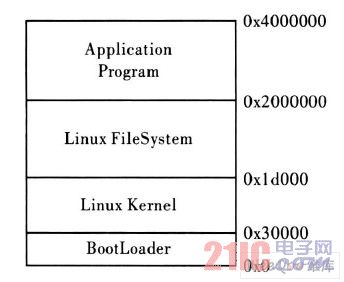
Figure 2 NAND Flash address allocation.
1.2 software design
The main task of the program design of the image acquisition module is to realize the coordination of the components of the module and to realize the reading of image data. Mainly divided into three parts.
(1) Logic design on CPLD. Written in VHDL, the program divides the 10 MHz input of the external crystal to provide clock and control signals for the C IS, ADC, FIFO, etc., and provides timing for the stepper motor.
(2) Tailoring, configuration, and porting of embedded Linux systems.
The system uses 26 cores and the host environment is Ubuntu804.
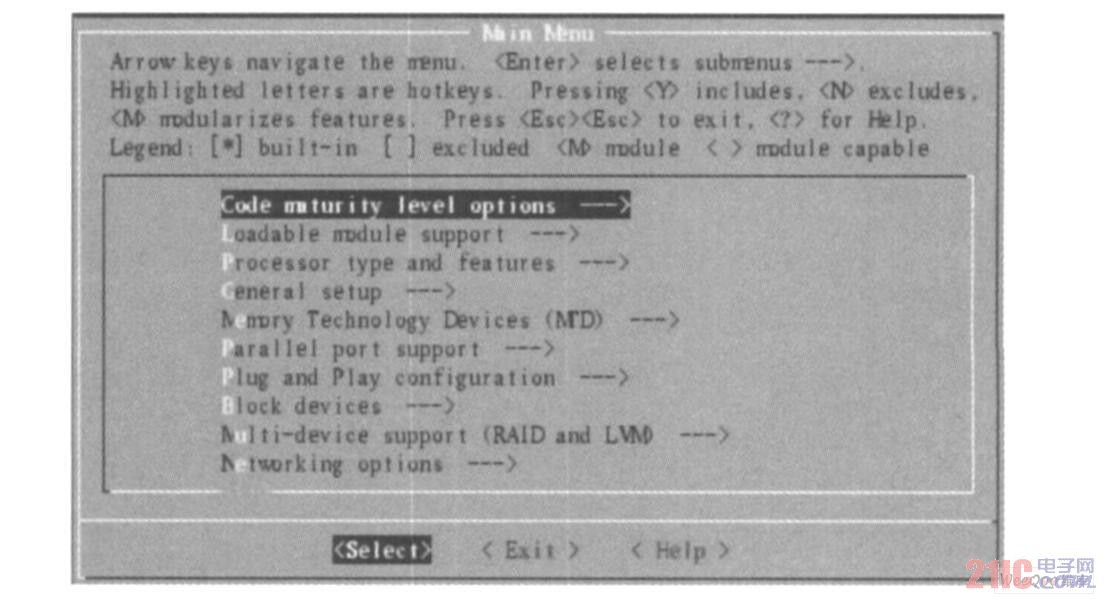
Figure 3L inux kernel configuration.
(3) Writing of the Linux driver. Since the acquisition module can be regarded as a device for the Linux system, the part of the program should be written as an embedded Linux device driver. The driver indirectly realizes the logic control of the acquisition module and the reading of the image data through the CPLD. Application development provides an interface to the underlying hardware [5]. The image data is read from the FIFO buffer by DMA, and the destination memory of the DMA is the SDRAM of the ARM system.
The working flow chart and image acquisition effect of the image acquisition module are shown in Figure 4 and Figure 5, respectively.

2. Image recognition module
The purpose of this paper is to build a universal character recognition system, and the image acquisition module realizes the acquisition of scanned image data. Because the system is based on embedded Linux, the subsequent image processing and character recognition software design can be separated from the hardware system independently. It has high versatility, and can develop and extend different recognition software according to the actual application. This paper only discusses handwritten numbers. Identify the application.
Identification algorithm:
Linear discriminant analysis (LDA) is one of the effective feature extraction methods, which is widely used in the fields of face recognition and character recognition [6]. The basic idea is to select a set of vectors that make the F isher criterion function reach the extreme value as the best projection direction. After the sample is projected on the vector set, the maximum inter-class dispersion and the smallest intra-class dispersion are achieved. To find the projection axis, the ratio of the inter-class discrete matrix Sb to the intra-class discrete matrix Sw should be maximized:

The interclass discrete matrix Sb and the intraclass discrete matrix Sw are defined as
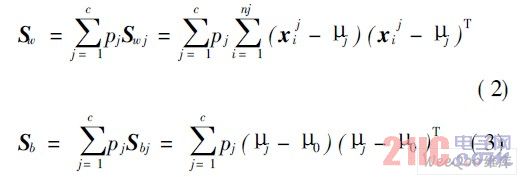
Where c is expressed as the number of categories of the pattern; j is expressed as the mean of the jth class (its probability is pj); 0 is the mean of all samples; xji is the h-dimensional vector of the j-th schema i; nj is the sample of the j-th class Number; N is the number of all samples. j and 0 are defined as:
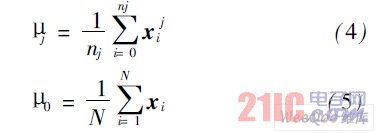
The optimization problem can be obtained by solving the eigenvalues ​​of Sb and Sw. If the proportion of non-target samples in the sample discrete matrix is ​​large, LDA does not guarantee the optimal subspace. The optimal classification criteria of LDA are not necessarily optimal for classification accuracy, and it is possible to cause unnecessary overlapping of adjacent classes that have been separated. This paper uses a new weighted LDA method (ILDA), which computes S^b and S^w as follows:
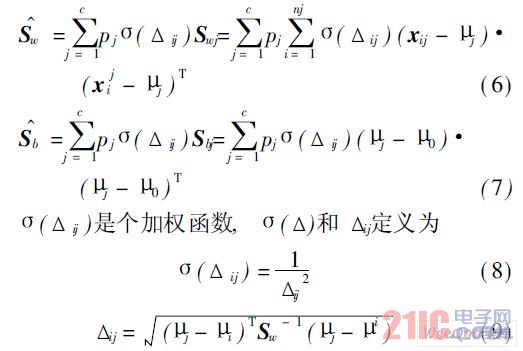
Obviously, if ( ) is a constant, S^b and S^w are equivalent to Sb and Sw, respectively, in the projection direction. If each class's ( ) is different, this will have an impact on the classification of overlapping samples of adjacent classes. It can be seen that if ij is larger, then ( ) is smaller.
The experimental samples were taken from the handwritten general database UC I. The weighted linear discriminant analysis and the corresponding algorithm were compared and analyzed under the Bhattacharyya distance (BD) classifier. The better recognition performance was obtained, which confirmed the effective extraction of the features. Sex.
3. Conclusion
In this paper, the embedded Linux and ARM processor software and hardware platform is used to realize image acquisition and storage by using C IS sensor and motion platform. An image acquisition platform is built for embedded character recognition system. In the application of character recognition, the widely used handwritten digit recognition algorithm is discussed. Based on the existing linear discriminant analysis algorithm, an improved weighted linear discriminant analysis algorithm is proposed. The algorithm is verified by experiments. A good recognition rate.
We are a pioneer firm with the main focus on offering a top class range of LED Street Light to our deemed patrons. Offered street lights are fabricated under the surveillance of professionals as per market trends. In addition to this, our quality editors take charge of delivering a flawless range at the patrons end to maintain pace with the patrons needs and requirements. Moreover, patrons can avail these products in various sizes and grades.We have LED Street Lights in the range of 30w to 200w. All are smd based with very high quality lens.We use high surge protection drivers and our product is ip67.
60W Led Street Lights,60W Led Street Light Solar,60W Led Street Lamp,60W Aluminium Led Street Light
Yangzhou Bright Solar Solutions Co., Ltd. , http://www.cnbrightsolar.com